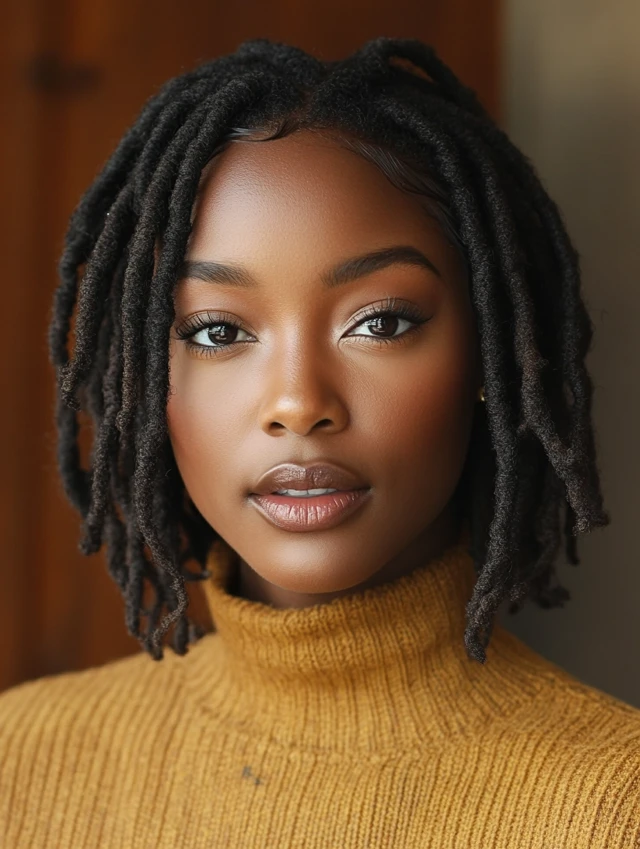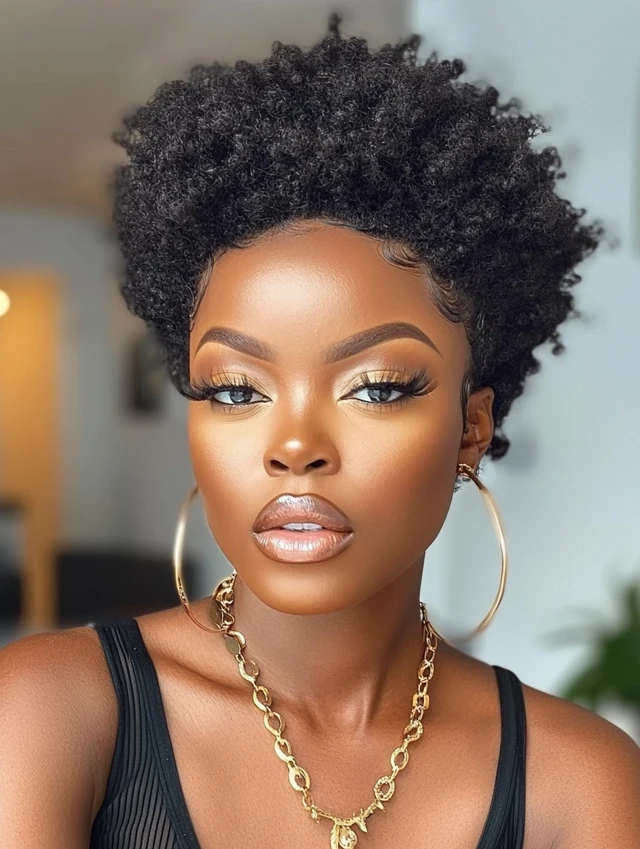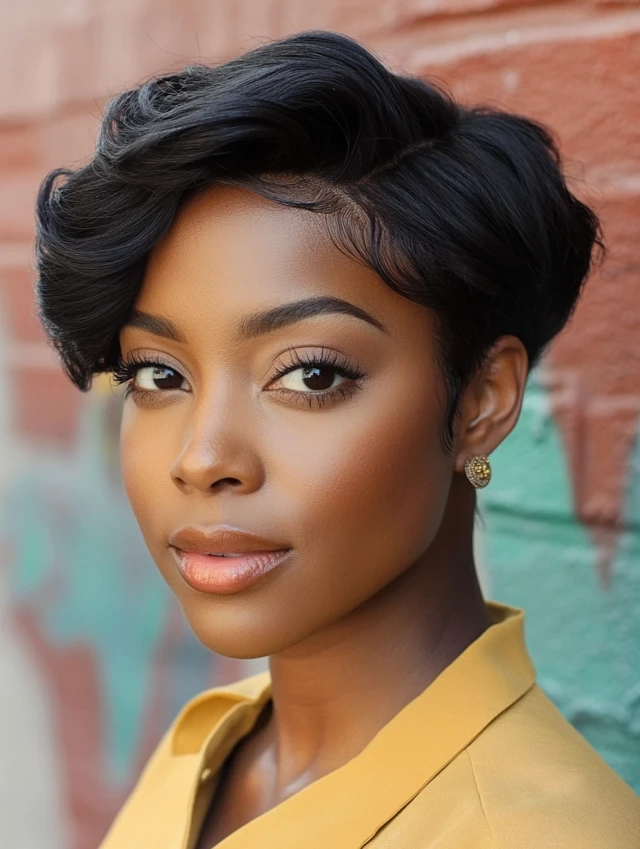What It Means to Choose Short Hair as a Black Woman
For Black women, hair has never been just hair. It’s been politics, it’s been poetry. It’s been pride, protest, beauty, and identity. And when you choose to cut it short—to strip it down to its texture, to its silhouette, to its roots—that’s not just a style decision. That’s a statement.
Short hairstyles for Black women are more than just a look. They’re a language. A way of saying: “This is who I am—without explanation.” Whether you’ve worn your hair short for years or you’re standing in front of the mirror with scissors in hand, preparing for a change that feels personal, permanent, and maybe even sacred, this journey is one built on more than fashion.
It’s about standing fully in your features. It’s about honoring your texture. And it’s about discovering what happens when there’s no hair to hide behind—only room to emerge.
A Legacy of Short Hair That Reaches Beyond the Present
There’s something powerful about tracing the line of short hair through Black history. The 1960s brought afros worn high and proud. The ’90s delivered clean fades, finger waves, and sculpted cuts that moved like water. Today, the options are infinite—but the intention is still the same: autonomy.
To cut your hair short is to create space for yourself. Not for standards. Not for assimilation. Not for someone else’s gaze.
From Grace Jones’ angular boldness to Lupita Nyong’o’s natural elegance, the short hair of Black women has never been passive. It leads. It claims the room. And it dares you to try and look away.
Texture as the Canvas, Not the Obstacle
No two curls are the same—and that’s exactly the point. Kinks, coils, waves, and everything in between all bring something different to short styles. But for Black women, especially those with 4B and 4C textures, short hair doesn’t flatten out or fall—it shapes. It stands. It expresses.
The tighter the coil, the greater the architecture. A teeny weeny afro (TWA) isn’t a compromise—it’s a sculpture. A tapered cut with your natural texture adds elegance without erasing softness. Waves molded against the scalp speak of rhythm and restraint. Even the freedom to let a cropped afro bloom without form or frame is itself a kind of styling choice—a declaration that your texture doesn’t need defining to be defined.
Hair doesn’t need to be manipulated into submission. It only needs to be invited to speak.
Styling With Intention, Not Obligation
One of the biggest shifts that happens after cutting your hair is the sudden simplicity of styling. But simplicity doesn’t mean boredom. It means intention.
You start paying attention to moisture. To texture. To how your hair lays differently day to day. Styling becomes less about protection and more about celebration. Maybe it’s brushing your curls out for volume. Maybe it’s shaping them inward. Maybe it’s choosing not to touch them at all.
Some days it’s slicked down edges and a side part. Other days it’s a twist and go. Some days, you just step outside with your natural crown exactly as it woke up—fluffed at the roots, kissed by your pillow, kissed by your ancestors, kissed by you.
And in those moments, your style doesn’t need approval. It already has purpose.
Haircuts That Hold Emotion, Not Just Shape
Ask any Black woman who’s done the big chop—or even a little chop—and she’ll tell you: there’s a moment of stillness right after the cut. When the cape comes off. When the mirror comes up. When you run your fingers across your scalp and feel not just absence, but presence.
Cutting your hair can feel like grief. It can feel like freedom. It can feel like both. You’re letting go of weight—literal and metaphorical. Maybe of a relationship. Maybe of a version of yourself that didn’t know how to be seen. Maybe of years of internalized ideas about what “professional,” “feminine,” or “beautiful” means.
And then something incredible happens.
You catch your reflection. And for the first time in a long time, you see your face. Not obscured by length or bundles or expectations. Just you. Just boldness. Just bone structure and bare skin and self.
That’s when the real style begins.
What Short Hair Reveals—and What It Doesn’t Need to Explain
Short hair makes you visible. There’s no hiding. No fallback. And for many Black women, that level of visibility can feel intense. We’re not often given the freedom to be seen on our own terms. But short hair demands that.
It asks you to own your presence. To carry confidence, even on days when it’s hard. And slowly, it teaches you that beauty isn’t something you add—it’s something you uncover.
Short hair doesn’t make you braver. But it reveals the bravery that was always there. It reminds you that softness doesn’t come from length. That femininity isn’t tied to inches. That power doesn’t require proof.
It invites you to dress differently. To hold your head differently. To exist without the extra.
Not because you have something to prove. But because you finally believe you don’t.
Cultural Reclamation Through Hair
The history of Black hair is riddled with tension. What was once punished or politicized is now paraded on runways. But in between, we’ve had to carve out our own space. And short natural hair—especially when worn unapologetically—has long been part of that resistance.
Waves molded with gel recall the glamour of the Harlem Renaissance. Shaved sides and angled fades echo Afro-punk rebellion. A TWA paired with gold hoops and bare shoulders feels as current as it is ancestral.
These aren’t just styles. They’re conversations with culture.
When you style your hair short and natural, you’re often stepping into a space where history, style, and identity converge. You’re showing up not just in the now—but in the continuum.
It’s hair. And it’s heritage.
Learning to Accessorize the Minimal
One of the joys of short hair is how it clears the stage for everything else. Your face becomes the centerpiece. So do your earrings. Your neck. Your shoulders. The clothes you wear. The way you move.
Suddenly, a bold earring becomes more than decoration—it becomes punctuation. A clean fade makes room for statement makeup. A soft curly afro brings out every angle of your cheekbone.
And on the days when you want to switch it up, accessories become extensions of mood. Scarves, clips, hats, headbands. Not to hide—but to highlight. Not to add drama—but to invite play.
With short hair, less is never lacking. It’s just more deliberate.
Short Hair Isn’t a Phase—It’s a Practice
There’s a misconception that short hair is something you “do” for a while—until it grows back, until you figure it out, until you move on. But for many Black women, short hair becomes a home. A return. A way of styling that feels sustainable, expressive, and grounded.
It’s not just the ease of washing and styling. It’s the emotional clarity that comes with not negotiating your hair’s shape, size, or identity every morning.
You stop chasing growth and start chasing glow. You stop styling to cover and start styling to center.
Short hair doesn’t mean you’ve given up. It means you’ve given in—to who you really are.
Check out this ideas and SAVE your favorite.
1. Tapered Afro
A tapered afro is a modern twist on a classic natural style. The sides and back are trimmed shorter, while the top is left full, curly, or coily.
Why it works: It flatters the face by adding height and dimension, and works beautifully with 3C to 4C textures.
Styling Tips:
- Use curl cream and a pick to shape the top.
- Define coils with finger coils or a sponge.
- Line up edges for a sharp, clean finish.
1

2

3

4

Best For: Bold, natural looks that highlight your crown and jawline.
2. Pixie Cut with Finger Waves
Finger waves are timeless, soft, and sophisticated. This close-cropped look hugs the scalp and adds artistic definition.
Why it works: It gives glam vintage vibes while being low-maintenance and high-impact.
Styling Tips:
- Apply setting foam to damp hair and sculpt waves with a comb.
- Use wave clips until fully dry.
- Add sheen spray for a polished look.
1

2

3

4

Best For: Formal events, retro lovers, and fine or relaxed hair.
3. Buzz Cut with Color
Nothing is as bold or liberating as a buzz cut—and adding vibrant color like blonde, red, or lavender takes it to the next level.
Why it works: It’s edgy, confident, and perfect for women who love standing out.
Styling Tips:
- Keep scalp moisturized with light oils.
- Refresh color with regular glosses or touch-ups.
- Use minimal product—your confidence is the main accessory.
1

2

3

4

Best For: High fashion energy, low-maintenance routines, and creative spirits.
4. Short Faux Locs Bob
Faux locs in a chin-length bob create texture, volume, and movement—without the long-term commitment of traditional locs.
Why it works: Protective, trendy, and perfect for switching things up seasonally.
Styling Tips:
- Choose a side or center part depending on face shape.
- Accessorize with loc cuffs or shells.
- Use mousse to keep frizz down.
1

2

3

4

Best For: Protective styling lovers, vacation hair, and expressive textures.
5. Bantu Knots
This traditional African style doubles as a protective look and a statement-making hairdo. Bantu knots are coiled sections pinned into tiny buns across the scalp.
Why it works: It honors cultural roots and is both fashionable and functional.
Styling Tips:
- Start on damp, moisturized hair.
- Twist tightly and secure each knot with an elastic or pin.
- For variation, add color or do a half-up style.
1

2

3

4

Best For: Cultural events, artistic personalities, and 4A–4C hair.
6. Short Box Braids
Box braids aren’t just for long hair—they look stunning in bob length. This style adds volume, structure, and personality.
Why it works: It’s protective, easy to maintain, and perfect for heat-free styling.
Styling Tips:
- Go for triangle parts or add color for flair.
- Style in buns, half-up looks, or pin-backs.
- Wrap at night with a satin scarf.
1

2

3

4

Best For: Active lifestyles, travel, and long-lasting wear.
7. Frohawk
The frohawk combines the boldness of a mohawk with the volume of natural curls. It’s edgy and stunning, whether sculpted or soft.
Why it works: It makes a strong statement while letting you play with texture.
Styling Tips:
- Pin sides with bobby pins or taper for a cleaner silhouette.
- Use a sponge or curl cream for definition.
- Highlight with color or designs on the shaved sides.
1

2

3

4

Best For: Creative, edgy women and special occasions.
8. Coily TWA (Teeny Weeny Afro)
The TWA celebrates natural coils in their purest, most powerful form. It’s short, easy to care for, and incredibly striking.
Why it works: It embraces shrinkage, highlights bone structure, and grows out beautifully.
Styling Tips:
- Hydrate with leave-in and seal with oil daily.
- Use a curl sponge or define with fingers.
- Accessorize with bold earrings or a headband.
1

2

3

4

Best For: Low-maintenance naturals and women starting their natural hair journey.
9. Side-Parted Relaxed Pixie
For those who prefer relaxed or straightened styles, a pixie with a dramatic side part adds glamour and face-framing elegance.
Why it works: It’s sleek, sophisticated, and perfect for professional settings or formal events.
Styling Tips:
- Flat iron or wrap at night to maintain smoothness.
- Add volume at the crown for extra shape.
- Apply serum for shine and flyaway control.
1

2

3

4

Best For: Relaxed hair wearers, professionals, and elegant occasions.
10. Short Crochet Curls
Crochet styles can mimic natural curls, kinks, or coils—while being protective and easy to install. A short crochet bob offers both volume and versatility.
Why it works: It’s low-manipulation and perfect for experimenting with different curl patterns.
Styling Tips:
- Use mousse to keep synthetic hair frizz-free.
- Fluff roots with a pick for volume.
- Trim ends for a custom shape.
1

2

3

4

Best For: Protective style enthusiasts, transitioners, and seasonal refreshes.
Every Cut, a Canvas
Whether you’re in the barber’s chair or at your bathroom sink, cutting your hair short is always an invitation to begin again.
It might be the fade that sharpens your silhouette. The undercut that lives quietly until it peeks out with power. The soft puff of coils that bloom upward after a fresh twist-out. The sleekness of a brush-cut that glistens in sunlight.
Each version of short hair is a variation on a theme. The theme? You. And the different ways you’re willing to show up in the world.
Not because your hair is the most important thing about you. But because it reflects something deeper: your willingness to take up space—boldly, beautifully, and without apology.
Final Thoughts: This Isn’t Just Hair—This Is How You Enter the Room
At the end of it all, short hair for Black women isn’t about trend or utility. It’s about truth. A truth that shows up in every coiled crown, every shaped edge, every twist, every part, every line.
Short hair is not a fallback. It’s not the thing you do when you’re in between. It’s not a compromise.
It’s a decision.
To strip away the extra.
To let the world see your face.
To let yourself take the spotlight.
To let your beauty live in structure, shape, and softness—all at once.
So when you style it tomorrow—whether it’s with shea butter and confidence or edge control and fire—remember: you’re not doing it for them.
You’re doing it for the mirror. For the mirror that finally reflects exactly who you were always meant to be.